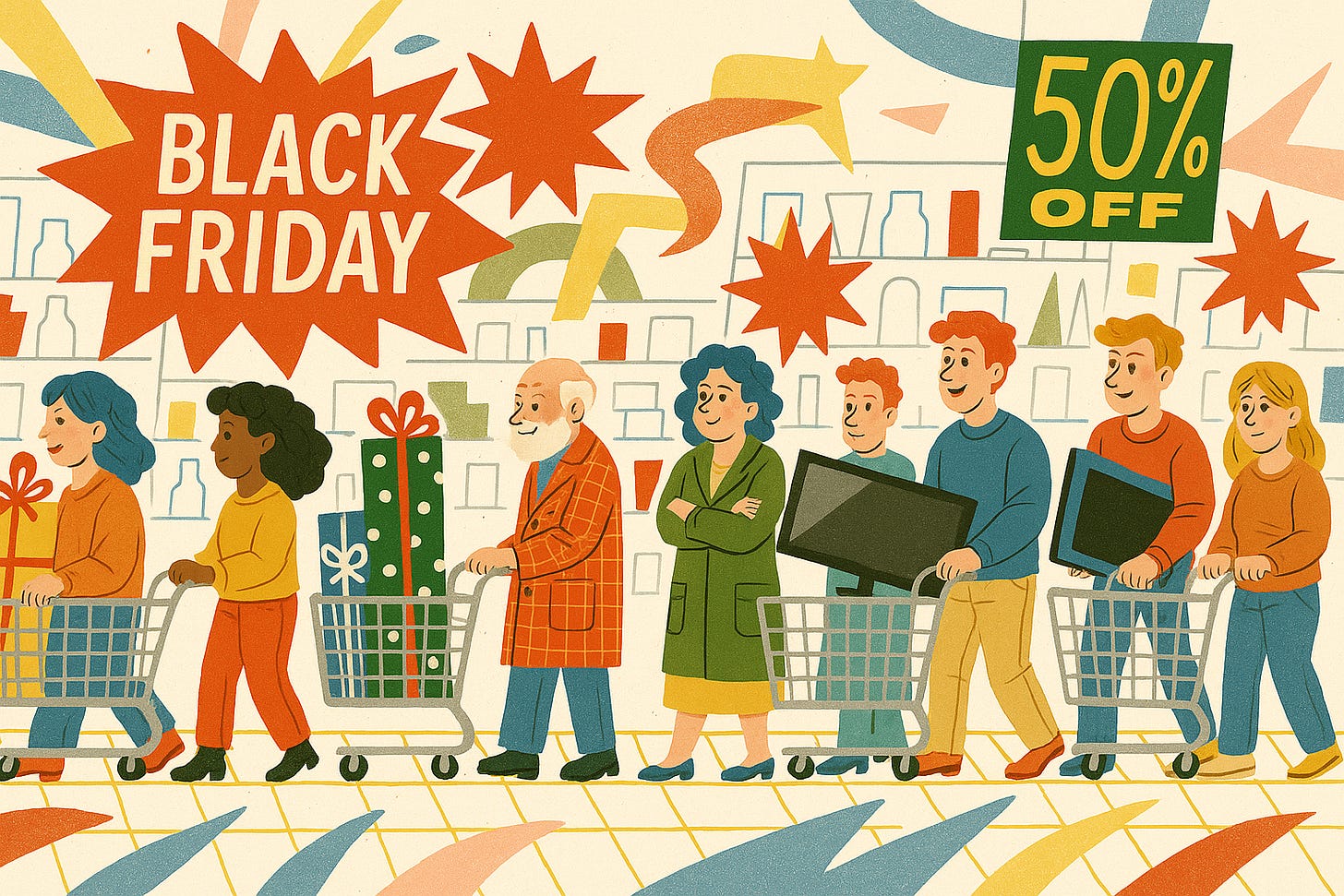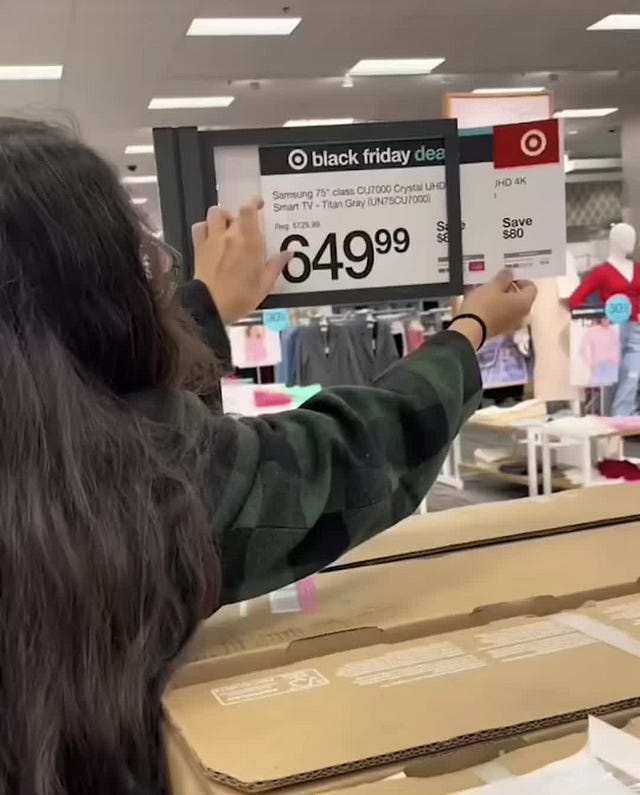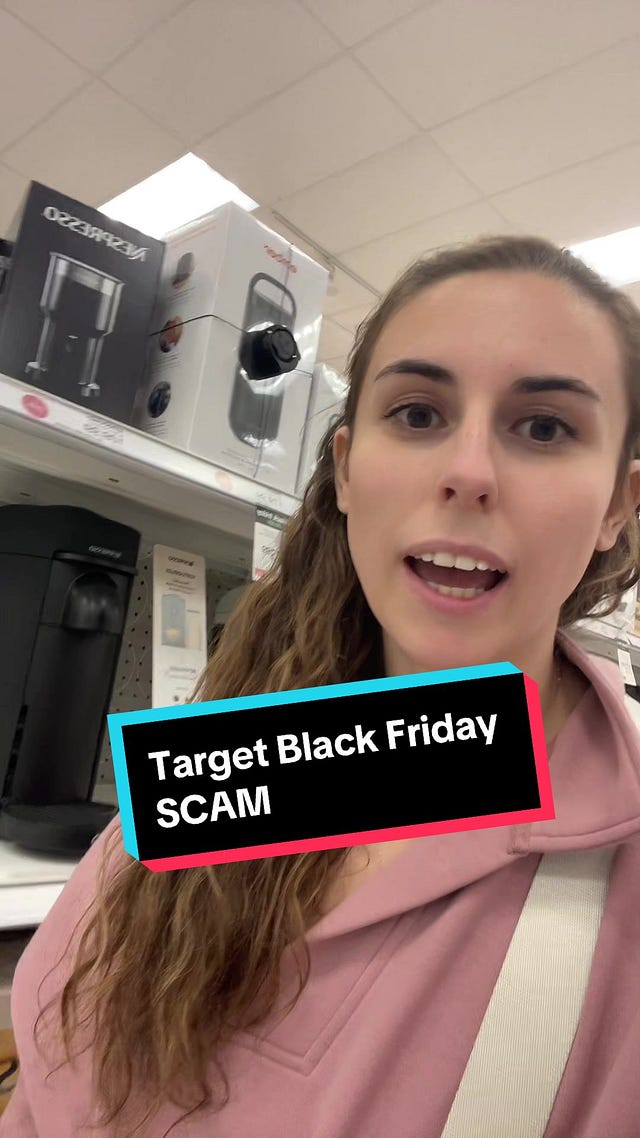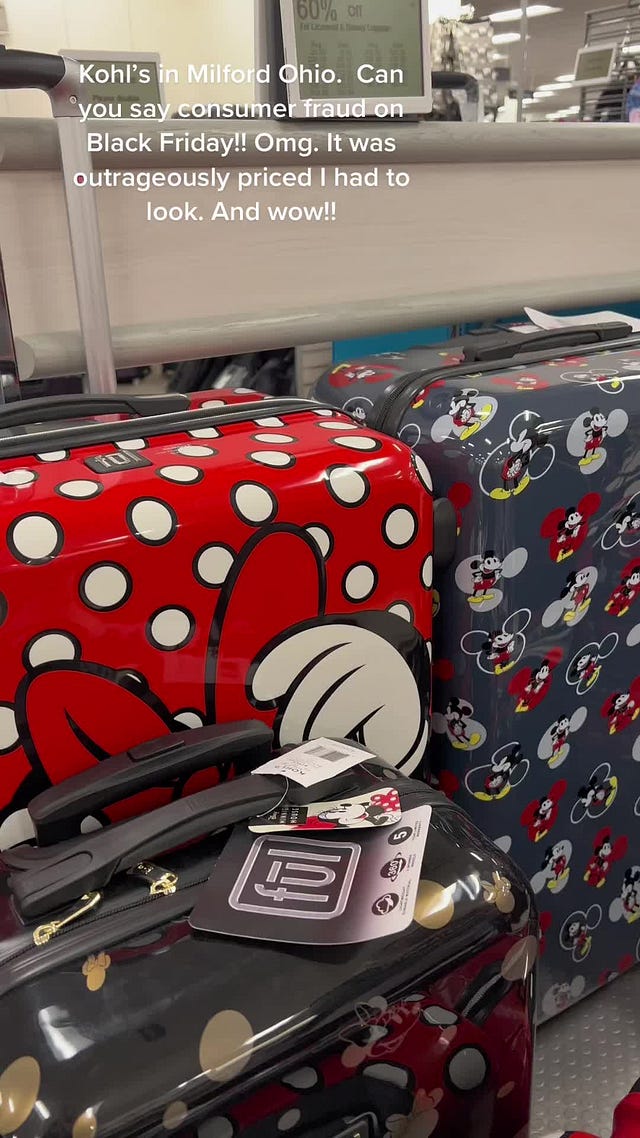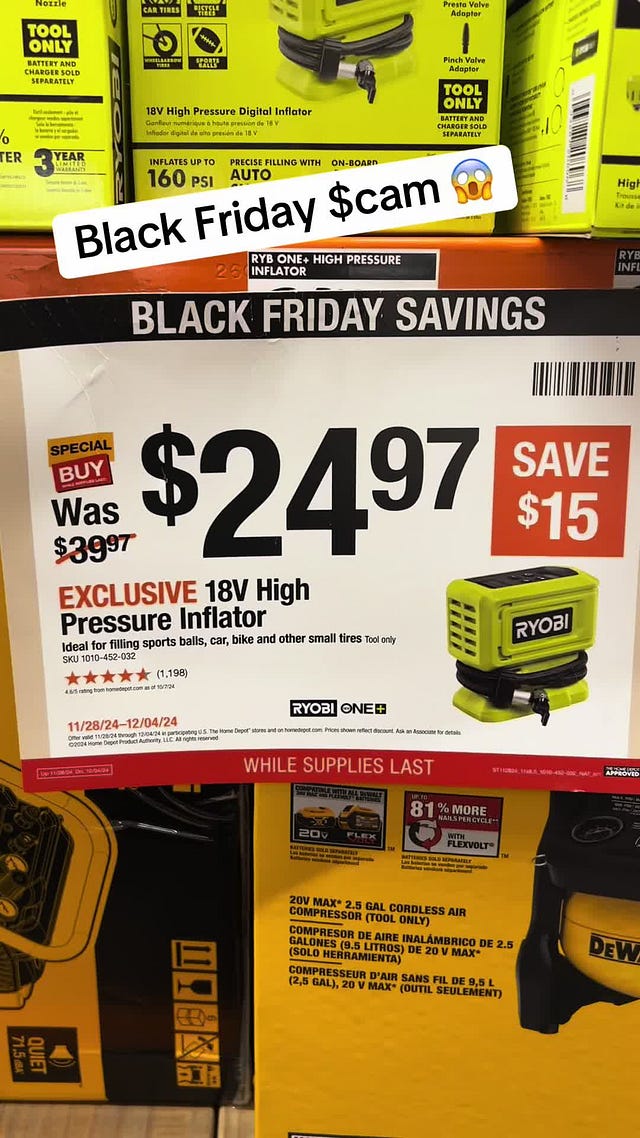Three Theories About Target, Kohl's & Home Depot's Black Friday Pricing Woes
Is it idiosyncratic sloppy pricing, an outdated understanding of pricing cues & shopper price knowledge, or a systematic ploy to influence shoppers through deception?
“Black Friday is such a joke nowadays. “Don’t miss out on 30% off” don’t piss me the fuck off. People used to hit each other over the head for a microwave that’s how low the prices were. People literally died. We used to be a country.” - Stantler on Tumblr
What a difference five years make. From angry crowds jostling for cut-rate TVs in the wee hours of Black Friday morning to virtually empty stores and forlorn checkout employees, it’s become a powerful sign of how holiday shopping has changed in recent years. Along with the waning popularity of Black Friday shopping in big-box retail stores, another trend has also emerged. On or around Black Friday (the day after Thanksgiving in the US), retailers like Target, Kohl’s, and Home Depot have been called out repeatedly on social media for their questionable Black Friday in-store promotions. Many of these videos have gone viral, garnering millions of views and a lot of negative publicity.
The videos typically involve shoppers walking through a store, examining price signs or tags, and comparing the sale prices to recent prices, or even to price tags that lie under the Black Friday price tag. When they do this, they find that the claimed Black Friday deals have the same or even much higher prices than prices just a few days before. The supposed amazing Black Friday deals turn out to be not deals at all!
Here are four examples of such TikTok videos. In the first one, a repost of a wildly viral video from 2023 that was deleted by the original poster, the content creator checks the prices of 65” and 75” Samsung Smart TVs. In both cases, she finds signs underneath those marked “Black Friday Deals” also labeled “Sale” with identical prices. The video ends with her saying, “I don’t get it. I am confused.” Take a look.
Target defended this shopper’s discovery by pointing out they had put the TVs on sale weeks earlier, but had updated the signage to reflect the Black Friday period (from “Sale!” to “black friday deals”). They effectively admitted that the Black Friday sale (at least for the TVs) was an extension of an ongoing sale and no better for the shopper than the previous sale.
In this next video from the 2024 Black Friday, the Target customer finds the in-store price of the 16-ounce Ember thermal mug marked down to $143.99 from the original $179.99 price, suggesting this is a good deal. However, she’d bought the same item for $79.99 online from Target just days earlier.
This third video is from Kohl’s, where a customer found a 60% off sale sign for Minnie Mouse luggage, marked down to $176 from $440. Under the $440 sticker, however, was the luggage’s regular price of $319.99. The discount was actually 45%, not 60%. The customer concluded that Kohl’s had raised the price prior to Black Friday to inflate the claimed discount.
This last video is from Home Depot, from their 2024 Black Friday sale. Here, the customer walks around in several aisles of the store, discovering that the store has simply stuck on new price tags labeled “Black Friday Savings” over regular prices that are identical.
 Tiktok failed to load.
Tiktok failed to load.Enable 3rd party cookies or use another browser
In these and many other videos, based on such in-store observations, consumers conclude that Black Friday promotions at these retailers are “scams,” where they are simply trying to trick consumers into thinking they are getting good deals. Obviously, there is some missing nuance in this conclusion, but the overall point of these content creators that Black Friday sales at Target, Kohl’s, and Home Depot are not compelling is a valid one.
At least one law firm, Pfeiffer Wolf, is “investigating Target and Kohl’s for their alleged misleading “Black Friday” sales practices, in which regularly-priced products and products already offered at sale prices were advertised as discounted “Black Friday” deals.” It wouldn’t be surprising to see class action lawsuits filed against these retailers.
It appears that the sloppy pricing approach seen in the videos during the Black Friday period is hurting these retailers in at least four obvious ways:
It is devaluing their brands and breaking trust with their core customers, because it can be argued that those who shop at these retail stores on Black Friday or during that weekend are among their more loyal and regular customers.
It is generating a lot of bad publicity that goes viral, resulting in significant negative effects on perceptions of the broader shopper base beyond the retailers’ core customers.
It is quite likely reducing their sales and profits earned during the historically important holiday period (in the US). For example, Kohl’s reported a 9.4% decline in sales and a 74% decline in profit year-over-year (both huge numbers) for the 2024 holiday season quarter. In the words of Ashley Buchanan (then Kohl’s CEO, since fired for other reasons) to analysts,
“We have a very loyal customer. When I toured stores, I heard how much they love Kohl’s. And what I realized was we’re kind of making it harder for them to love us1.”
It is exposing the retailers to potentially costly class-action lawsuits for misleading customers through artificially inflated and badly communicated sales and prices. Whatever you may think about the merits of this accusation, the liability is there.
This begs the question: Why have some of the largest and most successful American retailers been so sloppy with their Black Friday pricing strategy?
In this post, I want to propose three potential theories to help answer this question, some benign, others not so much.
The pricing anomalies we saw in the videos were outliers. It could be that the cases of sloppy pricing we saw in the viral videos were rare outliers. Under this theory, the content creators stumbled upon the few sloppily attached tags and sale signs in the store and pounced. In the quest to price thousands of SKUs before the store opens its doors for the Black Friday sale, some SKUs could have been mispriced by line employees or managers. Combine this with the fact that there are roving hordes of social media content creators who are out actively looking to find controversy and capitalize on it. Those who made these videos, the explanation goes, just got lucky; no videos were made of all the thousands of other items in the store that were tagged with the correct prices or were actually good deals.
Over-reliance of (corporate or store) managers on stylized, outdated assumptions about pricing cues and price knowledge. Consistent with the idea that the pricing anomalies we saw in the videos were sloppy, this theory suggests that retailers are making inaccurate assumptions about the current effectiveness of pricing cues and their shoppers’ price knowledge Much of the behavioral research on pricing cue effectiveness is now over two decades old and is well-known among retailers and shoppers because of how popular behavioral economics has become. For instance, in an influential paper, Anderson and Simester (1998) explained why sale signs work2, but also generated attention to the fact that they do work3. Through his engaging popular writing, Dan Ariely further spread this idea about sales signs.
The same point applies to price knowledge. By now, virtually every retailer and even many shoppers have learnt about the research on the poor price knowledge of shoppers. There are several classic studies that have shown that a vast majority of shoppers have poor price knowledge and don’t know the item’s price, even when they are asked right after they have placed it in their shopping cart4. A fair number have been found to be completely oblivious, not even able to come within 20% of the actual price paid5.
But if you look at the cites in the footnotes, you will see these studies are old, and possibly outdated in their conclusions. These papers' findings on poor shopper price knowledge are two, three, or even four decades old6. More recent studies are hard to find because they are hard to publish in good journals (not enough novelty, even if it would be very useful information to update), so our understanding of how knowledgeable today’s shoppers are about prices may be obsolete.
The use of social media, price tracking apps, and price comparison apps all increases visibility of prices, potentially informing consumers and boosting their knowledge and interpretation of prices. And even if they don’t know the prices of items they are interested in, it is relatively easy for shoppers to learn the average and the range of prices while shopping, inside the store. This theory suggests that store managers need to update their understanding of how their shoppers interact with posted prices and other pricing cues, and how this information works, explicitly or under the radar, in their buying decisions. Under this scenario, inconsistent prices and the use of pricing cues by retailers may hurt rather than influence their customers positively.
These pricing anomalies are nothing new, nor are they sloppy; this is an enduring, tried-and-tested retailer pricing strategy. A third, less benign, theory suggests that the viral videos are simply discovering and publicizing something that is widespread, systematic, and has been going on for decades in retail stores.
There’s definitely some evidence supporting this theory. For the sake of brevity, here, I will only focus on Kohl’s. Back in October 2002, Boston Globe reporter Bruce Mohl reported that7:
“Kohl's Department Stores regularly tempts shoppers with a blizzard of yellow sale signs and weekly circulars promising discounts of as much as 85 percent off the regular price, but a four-month Globe review indicates that the savings claims may be misleading and a violation of state advertising regulations.
The inquiry found that many items designated as being on sale at the Kohl's store in Medford were never or rarely sold at the regular price; the discounts claimed on store signs and in ads were often exaggerated because they were based on comparisons to largely fictitious regular prices.
A Little Tikes yellow dump truck offered the most extreme example. Sales signs would calculate savings off the regular price of $12.99. But in 30 inspections at the store over a four-month period from April through August the toy never sold at the regular price. It sold for $9.74, nearly 90 percent of the time, a price that was advertised as being 25 percent off. The rest of the time, it sold for even less. This week's Kohl's circular, with the headline on the front proclaiming "lowest prices of the season," promoted the toy truck at 50 percent off, or $6.49.
Four other items -- a girl's dress, a woman's blazer, a woman's sleeveless turtleneck, and a men's Dockers shirt -- never sold at the stated regular price during inspections before going on clearance. The five items that never sold at their regular price represented 27 percent of the 18 items in the Globe's market basket. All items were checked at the Kohl's in Medford, one of 13 the chain operates in Massachusetts.”
A 2003 follow-up investigation found that8 “Nine months after Attorney General Thomas F. Reilly warned Kohl's Department Stores to come into compliance with state advertising laws, the Wisconsin-based retailer continues to advertise discounts off of largely fictitious regular prices.”
Then in 2016, there was the well-publicized Mulder v. Kohl’s Department Stores, Inc. class-action lawsuit where the plaintiff alleged that she was induced to purchase products from Kohl’s that were deceptively advertised as being on sale, relative to “comparison prices.” She argued that these comparison prices were entirely concocted and had never been charged by Kohl’s or other retailers in the marketplace (again, the same fake high anchor story). Interestingly, this lawsuit was dismissed because:
“even accepting plaintiff’s allegations as true, she had “not suffered an economic injury” cognizable under Massachusetts law: “among other things, she has suffered no loss, and there is no sum of money that could be awarded to her that could ‘compensate’ her without providing a windfall.” Put simply, the court found that the plaintiff had purchased goods for an advertised price, and that it appeared those goods were, in fact, worth the advertised price she paid.”
The main accusation in these investigations was the use of an inflated and never-charged “regular” anchor by the retailer. Note that this is not too far from using other prices, discount percentages, and cues like sales signs for the same purpose as shown in the videos. There have been other investigations and lawsuits about various pricing issues involving not just Kohl’s but also Target and Home Depot.
The evidence from the Kohl’s lawsuits and this theory suggests that what the shoppers are posting on social media is not idiosyncratic or sloppy; rather, it is the tip of the iceberg, both in terms of the instances shown and the Black Friday timing. If this theory is valid, it could be that the misleading or sloppy signs and the inflated references that TikTokers have been discovering during Black Friday are also in play the other 364 days of the year throughout these stores.
In contrast, Target did much better, reporting 1.5% higher sales and 2.1% higher store traffic compared to the previous year in the fourth quarter of 2024.
Anderson, E. T., & Simester, D. I. (1998). The role of sale signs. Marketing Science, 17(2), 139-155.
Anderson, E., & Simester, D. (2003). Mind your pricing cues. Harvard Business Review, 81(9), 96-96.
Dickson, P. R., & Sawyer, A. G. (1990). The price knowledge and search of supermarket shoppers. Journal of Marketing, 54(3), 42-53.
Vanhuele, M., & Drèze, X. (2002). Measuring the price knowledge shoppers bring to the store. Journal of Marketing, 66(4), 72-85.
Gabor, A., & Granger, C. W. (1961). On the price consciousness of consumers. Journal of the Royal Statistical Society Series C: Applied Statistics, 10(3), 170-188.
Mohl, B. (2002). Massachusetts probe questions veracity, legality of Kohl’s savings claims, Boston Globe, October 18.
Mohl, B. (2003). Kohl's seems to ignore warning to comply with Massachusetts advertising laws, Boston Globe, July 23.




